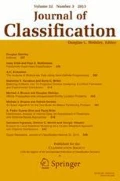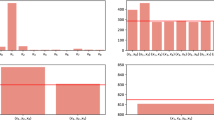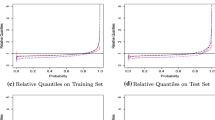Abstract
In this work, we analytically study the peaking phenomenon in the context of linear discriminant analysis in the multivariate Gaussian model under the assumption of a common known covariance matrix. The focus is finite-sample setting where the sample size and observation dimension are comparable. Therefore, in order to study the phenomenon in such a setting, we use an asymptotic technique whereby the number of sample points is kept comparable in magnitude to the dimensionality of observations. The analysis provides a more thorough picture of the phenomenon. In particular, the analysis shows that as long as the Relative Cumulative Efficacy of an additional Feature set (RCEF) is greater (less) than the size of this set, the expected error of the classifier constructed using these additional features will be less (greater) than the expected error of the classifier constructed without them. Our result highlights underlying factors of the peaking phenomenon relative to the classifier used in this study and, at the same time, calls into question the classical wisdom around the peaking phenomenon.


Similar content being viewed by others
References
Abend, K., & Harley, T.J.J. (1969). Comments on the mean accuracy of statistical pattern recognizers. IEEE Transactions on Information Theory, 14, 420–423.
Bowker, A., & Sitgreaves, R. (1961). An asymptotic expansion for the distribution function of the w-classification statistic. In Solomon, H (Ed.) Studies in item analysis and prediction (pp. 292–310): Stanford University Press.
Braga-Neto, U., & Dougherty, E. (2015). Error estimation for pattern recognition. New Jersey: Wiley-IEEE Press.
Campenhout, J.M.V. (1978). On the peaking of the Hughes mean recognition accuracy: the resolution of an apparent paradox. IEEE Transactions on Systems, Man and Cybernetics, 8, 390–395.
Chandrasekaran, B., & Jain, A.K. (1974). Quantization complexity and independent measurements. IEEE Transactions on Computers, 23, 102–106.
Couplet, R., & Debbah, M. (2013). Signal processing in large systems, a new paradigm. IEEE Signal Processing Magazine, 24–39.
Devroye, L., Gyorfi, L., & Lugosi, G. (1996). A probabilistic theory of pattern recognition. New York: Springer.
Duda, R.O., Hart, P.E., & Stork, D.G. (2000). Pattern classification. Wiley.
Efron, B. (2005). Bayesian, frequentists, and scientists. Journal of the American Statistical Association, 100, 1–5.
Girko, V.L. (1995). Statistical analysis of observations of increasing dimension. Dordrecht: Kluwer Academic Publishers.
Hirschhorn, J., & Daly, M.J. (2005). Genome-wide association studies for common diseases and complex traits. Nature Reviews Genetics, 6, 95–108.
Hua, J., Xiong, Z., Lowey, J., Suh, E., & Dougherty, E.R. (2005). Optimal number of features as a function of sample size for various classification rules. Bioinformatics, 21, 1509–1515.
Hughes, G.F. (1968). On the mean accuracy of statistical pattern recognizers. IEEE Transactions on Information Theory, 14, 55–63.
Jain, A., & Waller, W. (1978). On the optimal number of features in the classification of multivariate gaussian data. Pattern Recognition, 10, 365–374.
McLachlan, G. (2004). Discriminant analysis and statistical pattern recognition. New York: Wiley.
Moran, M. (1975). On the expectation of errors of allocation associated with a linear discriminant function. Biometrika, 62, 141–148.
Niu, G. (2017). Data-driven technology for engineering systems health management. Beijing: Science Press-Springer.
Raudys, S. (1967). On determining training sample size of a linear classifier. Computer Systems, 28, 79–87. In Russian.
Raudys, S. (2001). Statistical and neural classifiers an integrated approach to design. London: Springer.
Raudys, S.J., & Jain, A.K. (1991). Small sample size effects in statistical pattern recognition: recommendations for practitioners. IEEE Transactions on Pattern Analysis and Machine Intelligence, 13, 252–264.
Raudys, S., & Young, D.M. (2004). Results in statistical discriminant analysis: a review of the former soviet union literature. Journal of Multivariate Analysis, 89, 1–35.
Rubio, F., Mestre, X., & Palomar, D.P. (2012). Performance analysis and optimal selection of large minimum variance portfolios under estimation risk. IEEE Journal of Selected Topics Signal Process, 6, 337–350.
Serdobolskii, V.I. (1983). On minimum error probability in discriminant analysis. Soviet. Math. Dokl., 27, 720–725.
Serdobolskii, V.I. (2000). Multivariate statistical analysis: a high-dimensional approach. Kluwer Academic Publishers.
Serdobolskii, V. (2008). Multiparametric statistics. Elsevier.
Sitgreaves, R. (1961). Some results on the distribution of the W-classification statistics. In Solomon, H. (Ed.) Studies in item analysis and prediction (pp. 241–251). Stanford: Stanford University Press.
Sorum, M.J. (1973). Estimating the expected probability of misclassification for a rule based on the linear discriminant function: univariate normal case. Technometrics, 15, 329–339.
Waller, W., & Jain, A. (1978). On the monotonicity of the performance of Bayesian classifiers. IEEE Transactions on Information Theory, 24, 392–394.
Wigner, E.P. (1958). On the distribution of the roots of certain symmetric matrices. Annals of Mathematics, 67, 325–327.
Zhang, M., Rubio, F., Palomar, D.P., & Mestre, X. (2013). Finite-sample linear filter optimization in wireless communications and financial systems. IEEE Transactions on Signal Processing, 61, 5014–5025.
Zheng, N., & Xue, J. (2009). Statistical learning and pattern analysis for image and video processing. New York: Springer.
Zondervan, K.T., & Cardon, L.R. (2004). The complex interplay among factors that influence allelic association. Nature Reviews Genetics, 5, 89–100.
Zollanvari, A., & Dougherty, E.R. (2015). Generalized consistent error estimator of linear discriminant analysis. IEEE Transactions on Signal Processing, 63, 2804–2814.
Zollanvari, A., Braga-Neto, U.M., & Dougherty, E.R. (2011). Analytic study of performance of error estimators for linear discriminant analysis. IEEE Transactions on Signal Processing, 59, 4238–4255.
Acknowledgements
This material is based in part upon work supported by the Nazarbayev University Faculty Development Competitive Research Grant, under award number SOE2018008.
Author information
Authors and Affiliations
Corresponding author
Additional information
Publisher’s Note
Springer Nature remains neutral with regard to jurisdictional claims in published maps and institutional affiliations.
Rights and permissions
About this article
Cite this article
Zollanvari, A., James, A.P. & Sameni, R. A Theoretical Analysis of the Peaking Phenomenon in Classification. J Classif 37, 421–434 (2020). https://doi.org/10.1007/s00357-019-09327-3
Published:
Issue Date:
DOI: https://doi.org/10.1007/s00357-019-09327-3




